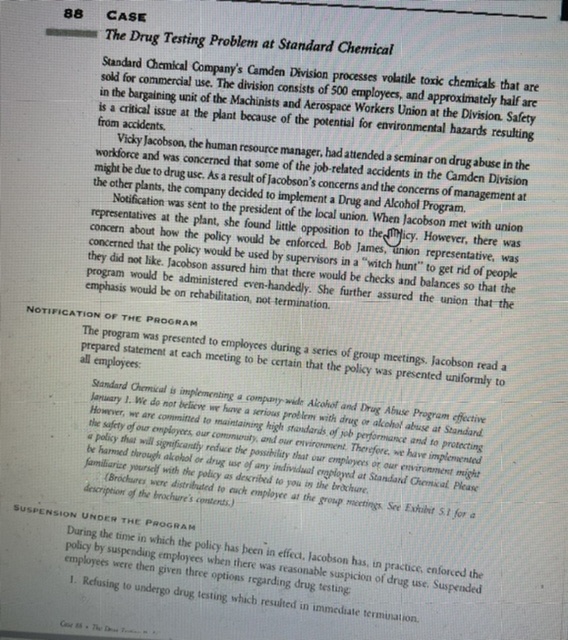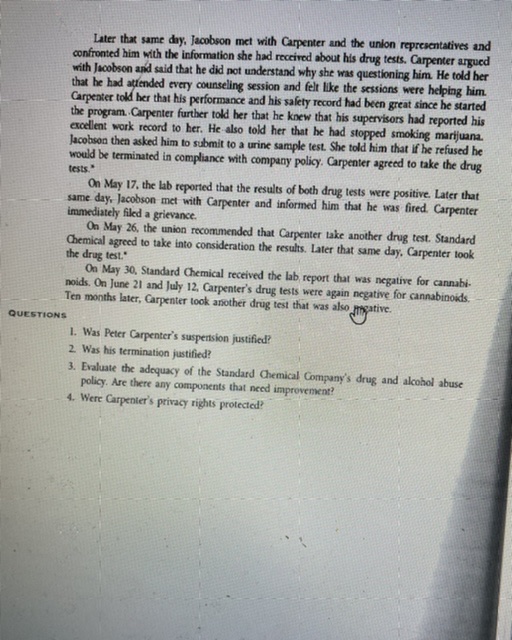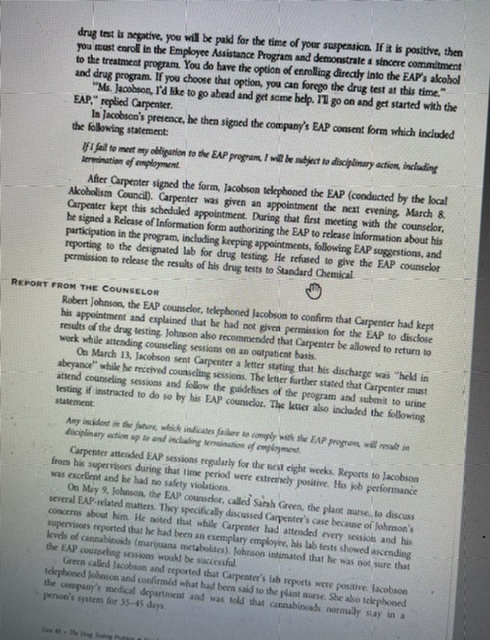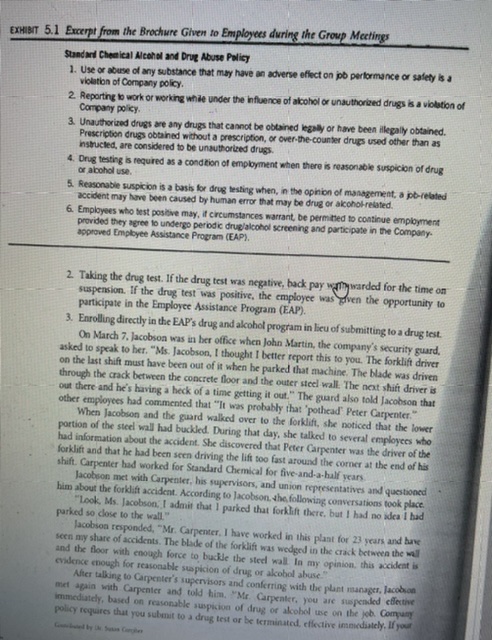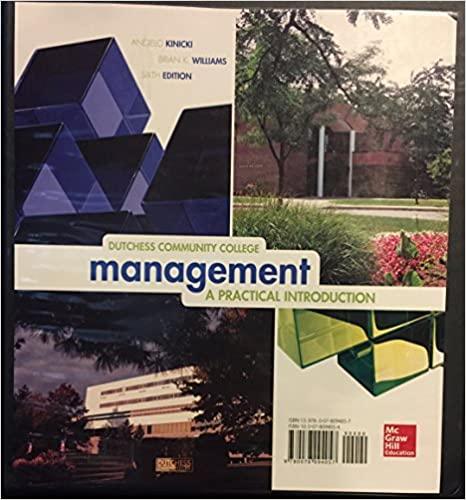Please assist with this case study
an overview of the case study first
88 CASE The Drug Testing Problem at Standard Chemical Standard Chemical Company's Camden Division processes volatile toxic chemicals that are sold for commercial use. The division consists of 500 employees, and approximately half are in the bargaining unit of the Machinists and Aerospace Workers Union at the Division. Safety is a critical issue at the plant because of the potential for environmental hazards resulting from accidents. Vicky Jacobson, the human resource manager, had attended a seminar on drug abuse in the workforce and was concerned that some of the job-related accidents in the Camden Division might be due to drug use. As a result of Jacobson's concerns and the concerns of management at the other plants, the company decided to implement a Drug and Alcohol Program. Notification was sent to the president of the local union. When Jacobson met with union representatives at the plant, she found little opposition to the Jmyicy. However, there was concern about how the policy would be enforced. Bob James, union representative, was concerned that the policy would be used by supervisors in a "witch hunt" to get rid of people they did not like. Jacobson assured him that there would be checks and balances so that the program would be administered even-handedly. She further assured the union that the emphasis would be on rehabilitation, not termination. NOTIFICATION OF THE PROGRAM The program was presented to employees during a series of group meetings. Jacobson read a prepared statement at each meeting to be certain that the policy was presented uniformly to all employees: Standard Chemical is implementing a company wide Alcohol and Drug Abuse Program effective January 1. We do not believe we have a serious problem with drug or alchol abuse at Standard Hourver, or are committed to maintaining high standards of job performance and to protecting the safety of our employers, our comuniouty, and our environment. Therefore, we have implemented a policy that will significantly reduce the possibility that our employers or our environment might be harmed through alcohol or drug war of any individual ergplayed at Standard Chemical Please familiarize yourself with the policy as described to you in the brochure. (Brochures were distributed to rack employee at the group meetings. See Exhilar S.1 for a description of the brochure's contents.) SUSPENSION UNDER THE PROGRAM During the time in which the policy has been in effect. Jacobson has, in practice, enforced the policy by suspending employees when there was reasonable suspicion of drug use. Suspended employees were then given three options regarding drug testing 1. Refusing to undergo drug testing which resulted in immediate termination.Later that same day, Jacobson met with Carpenter and the union representatives and confronted him with the information she had received about his drug tests. Carpenter argued with Jacobson and said that he did not understand why she was questioning him. He told her that he had attended every counseling session and felt like the sessions were helping him. Carpenter told her that his performance and his safety record had been great since he started the program. . Carpenter further told her that he knew that his supervisors had reported his excellent work record to her. He also told her that he had stopped smoking marijuana Jacobson then asked him to submit to a urine sample test. She told him that if he refused he would be terminated in compliance with company policy. Carpenter agreed to take the drug tests On May 17. the lab reported that the results of both drug tests were positive. Later that same day, Jacobson met with Carpenter and informed him that he was fired. Carpenter immediately filed a grievance. On May 26, the union recommended that Carpenter lake another drug test. Standard Chemical agreed to take into consideration the results. Later that same day. Carpenter took the drug test." On May 30, Standard Chemical received the lab report that was negative for cannabi- noids. On June 21 and July 12, Carpenter's drug tests were again negative for cannabinoids, Ten months later, Carpenter took another drug test that was also rogative. QUESTIONS 1. Was Peter Carpenter's suspension justified? 2. Was his termination justified? 3. Evaluate the adequacy of the Standard Chemical Company's drug and alcohol abuse policy. Are there any components that need improvement? 4. Were Carpenter's privacy rights protected?drug test is negative, you will be paid for the time of your suspension. If it is positive, then you must enroll in the Employee Assistance Program and demonstrate a sincere commitment to the treatment program. You do have the option of enrolling directly into the EAP's alcohol and drug program. If you choose that option, you can forego the drug test at this time." "Ms. Jacobson, I'd like to go ahead and get some help. I'll go on and get started with the EAP," replied Carpenter. In Jacobson's presence, be then signed the company's EAP consent form which included the following statement: If I fel to meet my obligation to the EAP program. I will be subject to disciplinary action, including Termination of employment After Carpenter signed the form, Jacobson telephoned the EAP (conducted by the local Alcoholism Council). Carpenter was given an appointment the next evening, March 8 Carpenter kept this scheduled appointment. During that first meeting with the counselor, he signed a Release of Information form authorizing the EAP to release information about his participation in the program, including keeping appointments, following EAP suggestions, and reporting to the designated lab for drug testing, He refused to give the FAP counselor permission to release the results of his drug tests to Standard Chemical REPORT FROM THE COUNSELOR Robert Johnson, the EAP counselor, telephoned Jacobson to confirm that Carpenter had kept his appointment and explained that he had not given permission for the EAP to disclose results of the drug testing. Johnson also recommended that Carpenter be allowed to return to work while attending counseling sessions on an outpatient basis. On March 13, Jacobson sent Carpenter a letter stating that his discharge was "held in abeyance" while he received counseling sessions. The letter further stated that Carpenter must attend counseling sessions and follow the guidelines of the program and submit to urine testing if instructed to do so by his EAP counselor. The letter also included the following Any isa dent in the future, which indicates failure to comply with the EAP program will result in disciplinary action up te and including termination of employment. Carpenter attended EAP sessions regularly for the new eight weeks. Reports to Jacobson from his supervisors during that time period were extremely positive. His job performance was excellent and he had no safety violations. On May 9. Johnson, the EAP counselor, called Sarah Green, the plant nurse, to discuss several EAP-related nutters. They specifically discussed Carpenter's case because of Johnson's concerns about him. He noted that while Carpenter had attended every session and his supervisor reported that be had been an caemplery employee, his lab tests showed ascending levels of cannabinoids (marijuana metabolites). Johnson intimated that he was not sure that the EAP counseling sessions would be successful. Green called Jacobson and reported that Carpenter's lab reports were positive. Jacobson telephoned Johnson and confirmed what had been said to the plant nurse. She sho telephoned the company's medical department and was told that cannabinoids normally stay in a person's system for 35-45 days.EXHIBIT 5.1 Excerpt from the Brochure Given to Employees during the Group Meetings Standard Chemical Alcohol and Drug Abuse Policy 1. Use or starve of any substance that may have an adverse effect on job performance or safety is a violation of Company policy. 2. Reporting to work or working while under the influence of alcohol or unauthorized drugs is a violation of Company policy. 3. Unauthorized drugs are any drugs that cannot be obtained legally or have been illegally obtained. Prescription drugs obtained without a prescription, or over the counter drugs used other than as instructed, are considered to be unauthorized drugs. 4. Drug testing is required as a condition of employment when there is reasonable suspicion of drug or alcohol use. 5. Reasonable suspicion is a bash for drug testing when, in the opinion of management, a pb-related accident may have been caused by human error that may be drug or alcohol-related. 6. Employees who best positive may, if circumstances warrant, be permitted to continue employment provided they agree to undergo periodic drug/alcohol screening and participate in the Company- approved Employee Assistance Program (EAP). 2. Taking the drug test. If the drug test was negative, back pay waThy warded for the time on suspension. If the drug test was positive, the employee was given the opportunity to participate in the Employee Assistance Program (EAP). 3. Enrolling directly in the EAP's drug and alcohol program in beu of submitting to a drug test. On March 7. Jacobson was in her office when John Martin, the company's security guard. asked to speak to her. "Ms. Jacobson, I thought I better report this to you. The forklift driver on the last shift must have been out of it when he parked that machine. The blade was driven through the crack between the concrete floor and the outer steel wall. The next shift driver is out there and he's having a heck of a time getting it out." The guard also told Jacobson that other employees had commented that "It was probably that "pothead" Peter Carpenter." When Jacobson and the guard walked over to the forklift, she noticed that the lower portion of the steel wall had buckled. During that day, she talked to several employees who hud information about the accident. She discovered that Peter Carpenter was the driver of the forklift and that he had been seen driving the lift too fast around the corner at the end of his shift. Carpenter had worked for Standard Chemical for five-and-a-half years. Jacobson met with Carpenter, his supervisors, and union representatives and questioned him about the forklift accident. According to Jacobson the following conversations took place "Look, Ms. Jacobson, I admit that I parked that forklift there, but I had no idea I had parked so close to the wall" Jacobson responded, "Mr. Carpenter, I have worked in this plant for 23 years and have seen my share of accidents. The blade of the forklift was wedged in the crack between the wall and the floor with enough force to buckle the steel wall In my opinion, this accident is evidence enough for reasonable suspicion of drug or alcohol abuse." After talking to Carpenter's supervisors and conferring with the plant manager, Jacobson met again with Carpenter and told him. "Mr. Carpenter, you are suspended chirthe immediately, based on reasonable suspicion of drug or alcohol use on the job. Company policy requires that you subout to a drug test or be terminated, effective immediately, If your
